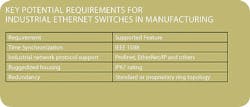Suppliers frequently differentiate themselves in this segment by using proprietary ring topologies to implement redundancy and improve network recovery times. An emerging trend is for suppliers to add value to their managed switches through network management capabilities and support for Layer 3 functionality.Unlike high-availability configurations in commercial information technology (IT), redundancy in industrial Ethernet networks is most often implemented using a ring topology. In the “race to the bottom” for network recovery times, these ring architectures remain key supplier differentiators. This battle now extends into sub-ring and chain architectures designed to further drive down recovery times. Moxa Inc.’s (www.moxa.com) Turbo Chain, for example, is compatible with standard Institute of Electrical and Electronics Engineers IEEE 802.1w/D RSTP and STP protocols, and can be integrated into any existing Ethernet network. The company claims that the technology requires fewer coupling cables and Ethernet ports, and significantly reduces deployment costs and effort compared to traditional ring coupling.Redundancy specifiedIEC 62439, promulgated by the International Electrotechnical Commission, will advance adoption of standard ring topologies. This is designed to fill a gap in the IEC 61850 standard for electrical substation automation, which does not specify a redundancy scheme. A 2010 update that replaces the 2008 release of the IEC 62439 standard features key additions. These include a calculation method for the Rapid Spanning Tree Protocol (RSTP) specified in IEEE 802.1Q and two new redundancy protocols: HSR (High-availability Seamless Redundancy) and DRP (Distributed Redundancy Protocol).Experts typically recommend network management capabilities and a distinct network management system when deploying a large number of switches. As the number of switches used in a given application increases, this capability assumes increasing importance. The proprietary ring topologies used by many of today’s industrial Ethernet switches precludes use of a commercially sourced network management system (NMS). Ability to graphically display, configure and troubleshoot Ethernet-based networks, typically via a Web browser, is a primary value proposition for industrial network management systems. So is traffic management, which allows the configuration to accommodate the varying capacities of different automation devices. Several suppliers have introduced network management systems based on the OPC open connectivity standard, which makes them even more familiar to a growing number of potential users.One caveat in this area is the reality that many of the existing industrial network management systems support only a single vendor’s devices. Multi-vendor management capabilities that reflect the reality of current and potential installations are best, requiring support for standard network management protocols, particularly versions of SNMP (Simple Network Management Protocol).Support for Layer 3 capabilities offers another means to differentiate managed switches. An increasing number of industrial Ethernet switches either currently offer this capability, or will soon. Examples include products from Cisco, Rockwell Automation and Phoenix Contact. Layer 3 switches can perform all or most of the functions of a network router, in particular, communication between different Internet Protocol (IP)-based subnetworks or VLANs (virtual local area networks).Increased support of Layer 3 functionality in industrial Ethernet switches indicates not only the push to add incremental value to these devices, but also the increasing convergence of IT and automation networks. These devices and their associated support of IP and other COTS-type (for Commercial Off-The-Shelf) services are typically oriented more toward IT than engineering, and often entail collaboration between these two organizations.Chantal Polsonetti, [email protected], is Vice President, ARC Advisory Group Inc., in Dedham, Mass.Moxa Inc.www.moxa.com
Subscribe to Automation World's RSS Feeds for Columns & Departments

